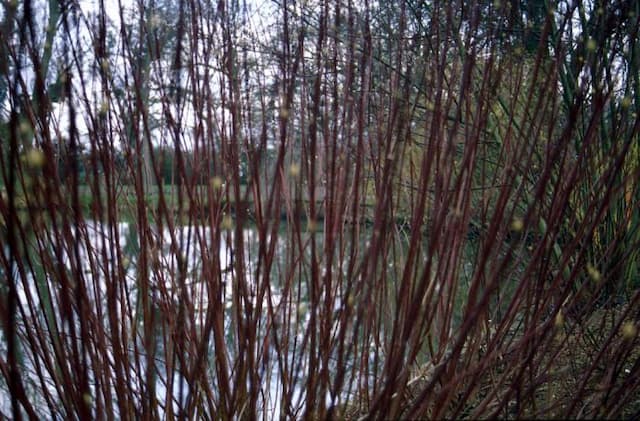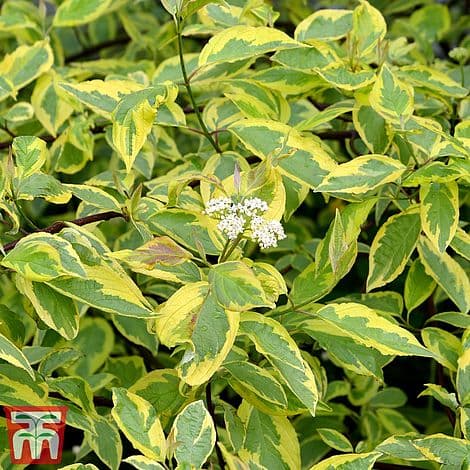Red Osier Dogwood Cornus sericea 'Bud's Yellow'

ABOUT
The Cornus sericea 'Bud's Yellow', commonly known as the yellow twig dogwood, is a deciduous shrub noted for its striking stem color that stands out particularly during the winter months. This plant showcases multiple upright, spreading branches. During the growing season, it is adorned with broad, oval-shaped leaves that are a rich green color. As the seasons change, these leaves often take on warm hues of reddish-orange to purple before falling off in the fall, revealing the bright yellow, round stems that give this plant its common name. The yellow twig dogwood produces clusters of small white flowers during the late spring to early summer, which develop into small bluish-white berries. This berry display can attract birds and other wildlife to the garden. The bark on mature branches peels slightly, adding textural interest throughout the year, in addition to the contrast between the yellow twigs and other plantings or snow in wintertime landscapes. This shrub is also appreciated for its versatility in the landscape, often used for mass plantings, as an accent plant, or even for erosion control on slopes due to the spreading nature of its root system. Its seasonal changes and vibrant stem color make it a dynamic component in many garden designs.
About this plant
 Names
NamesFamily
Cornaceae
Synonyms
Yellowtwig Dogwood, Golden-Twig Dogwood, Bud's Yellow Dogwood
Common names
Cornus stolonifera 'Bud's Yellow', Swida sericea 'Bud's Yellow'
 Toxicity
ToxicityTo humans
The Red Osier Dogwood, Cornus sericea 'Bud's Yellow', is not commonly listed as a toxic plant to humans. However, while it is not considered highly toxic, ingesting parts of the plant, particularly the berries, in large quantities may cause stomach upset or nausea. Symptoms would likely be limited to gastrointestinal discomfort if toxicity were observed.
To pets
The Red Osier Dogwood, Cornus sericea 'Bud's Yellow', is not typically known to be toxic to pets. However, as with any plant, the consumption of non-food items can result in gastrointestinal distress in some animals, which may manifest as vomiting, diarrhea, or a lack of appetite. If a pet ingests this plant and exhibits any concerning symptoms, it is advisable to consult a veterinarian.
 Characteristics
CharacteristicsLife cycle
Perennials
Foliage type
Deciduous
Color of leaves
Green
Flower color
White
Height
6 feet (1.8 meters)
Spread
8 feet (2.4 meters)
Plant type
Shrub
Hardiness zones
3
Native area
North America
Benefits
 General Benefits
General Benefits- Ornamental Appeal: Offers vibrant yellow-green stems that add a burst of color to winter landscapes.
- Wildlife Attraction: Produces berries that are a food source for birds and other wildlife.
- Natural Erosion Control: The root system helps stabilize soil and prevent erosion on slopes or beside water bodies.
- Seasonal Interest: Features white flowers in spring and colorful leaves in the fall, providing year-round interest.
- Easy to Grow: Adapts well to a variety of soil conditions and is relatively low maintenance.
- Screening Plant: Can be used as a hedge or privacy screen due to its dense growth habit.
- Supports Biodiversity: Offers shelter to wildlife and acts as a host plant for butterfly and moth larvae.
 Medical Properties
Medical PropertiesThis plant is not used for medical purposes.
 Air-purifying Qualities
Air-purifying QualitiesThis plant is not specifically known for air purifying qualities.
 Other Uses
Other Uses- Wildlife Habitat: Red osier dogwood provides shelter and nesting sites for birds and other wildlife.
- Winter Interest: The bright yellow stems of 'Bud's Yellow' add vibrant color to the winter landscape when most other plants are dormant.
- Soil Stabilization: Because of its spreading root system, red osier dogwood can help prevent soil erosion on banks and slopes.
- Streambank Restoration: It is often used in riparian buffer plantings to help filter runoff and maintain streambank integrity.
- Natural Dyes: The bark and leaves can be used to create natural dyes for fabrics or crafts.
- Photography: Its striking winter appearance makes it an excellent subject for nature and landscape photography during the colder months.
- Culinary Garnish: Although not edible, the bright winter stems can be used as a decorative garnish on food platters or to add flair to floral arrangements.
- Educational Tool: Red osier dogwood can be used in schools and educational programs to teach about native plants and their role in local ecosystems.
- Winter Sports Landscaping: The plant can be incorporated into the design of areas used for winter sports to add winter interest and reduce wind impact on open spaces.
- Festive Decoration: Branches of 'Bud's Yellow' can be cut and used to create holiday wreaths and other festive decorations.
Interesting Facts
 Feng Shui
Feng ShuiThe Red Osier Dogwood is not used in Feng Shui practice.
 Zodiac Sign Compitability
Zodiac Sign CompitabilityThe Red Osier Dogwood is not used in astrology practice.
 Plant Symbolism
Plant Symbolism- Stability and Hope: The Cornus sericea, commonly known as Red Osier Dogwood, often symbolizes stability and hope. Its resilient nature and ability to thrive in various conditions reflect the human capacity to withstand adversity and maintain optimism.
- Renewal and Vitality: Dogwoods are harbingers of spring, blooming with vibrant life after winter's dormancy. This cycle of rebirth represents renewal and the invigorating force of nature, reminding us of new beginnings and the rejuvenation of spirit.
- Purity and Innocence: In various cultural traditions, dogwoods are associated with purity and innocence, partly because of their delicate white flowers that have been connected to themes of cleanliness and virtue.
- Christian Symbolism: For Christians, the dogwood holds special significance as it is often believed that the tree was used to make the cross of Jesus. Thus it symbolizes faith, sacrifice, and resurrection.
 Water
WaterRed osier dogwood should be watered regularly, especially during its first growing season to help establish a deep, extensive root system. After establishment, it's tolerant of occasional dry spells. Typically, an inch of water per week, either through rainfall or manual watering, is sufficient. Adjust the amount during extreme heat or drought, aiming to provide up to 1.5 inches weekly. Water slowly and deeply using a drip irrigation system or a soaker hose to ensure the water penetrates thoroughly to the roots rather than running off.
 Light
LightRed osier dogwood thrives best in full sun to partial shade. It is adaptable but prefers a spot that receives at least 4 hours of direct sunlight each day, with some shelter from the harsh afternoon sun. Planting near the edge of a wooded area or where it can get morning sun and afternoon shade is often ideal for ensuring vibrant foliage and healthy growth.
 Temperature
TemperatureThe red osier dogwood grows well in a wide range of temperatures and is hardy from USDA zones 2 through 8. It can endure minimum winter temperatures down to -50 degrees Fahrenheit and maximum summer temperatures of around 100 degrees Fahrenheit. Ideally, it fares best in moderate conditions where temperatures are generally between 65 and 75 degrees Fahrenheit during the growing season.
 Pruning
PruningPruning red osier dogwood is important to encourage vibrant stem color and healthy growth. Pruning should be done in late winter or early spring before new growth begins. Annually remove about a third of the oldest stems to ground level, which promotes the growth of new, brightly colored stems. Also, cut out any damaged or diseased wood at this time.
 Cleaning
CleaningAs needed
 Soil
SoilRed Osier Dogwood thrives in a soil mix consisting of equal parts garden soil, compost, and peat or coir for moisture retention. An ideal soil pH for this shrub ranges from 5.5 to 7.0, slightly acidic to neutral.
 Repotting
RepottingRed Osier Dogwood, being a larger shrub, is not commonly repotted. If grown in containers, young plants may be repotted every 2-3 years to encourage growth.
 Humidity & Misting
Humidity & MistingRed Osier Dogwood prefers average to high humidity levels but is adaptable to a wide range of humidity conditions found in typical outdoor environments.
 Suitable locations
Suitable locationsIndoor
Provide bright light, cool temps, and moist soil.
Outdoor
Full sun to partial shade, moist soil, regular mulching.
Hardiness zone
3-7 USDA
 Life cycle
Life cycleCornus sericea 'Bud's Yellow', commonly known as Yellowtwig dogwood, begins its life cycle as a seed which, after a period of dormancy, germinates in favorable conditions of moisture and temperature. The seedling emerges and develops into a young plant with characteristic green leaves, which over successive years develops a robust root system and woody stems. The mature shrub flowers in late spring to early summer, bearing clusters of small white blooms that are followed by white or bluish fruit. Pollination usually involves insects, and once fertilized, these flowers will set seed, completing the reproductive cycle. Throughout the growing season, the stems of this cultivar display a bright yellow color, which is especially notable in winter after the leaves have fallen. Finally, as a perennial, the Yellowtwig dogwood enters a period of dormancy during the winter months, conserving energy before resuming growth in the spring.
 Propogation
PropogationPropogation time
Early spring
Cornus sericea 'Bud's Yellow', commonly known as Yellow Twig Dogwood, is typically propagated during its dormancy period, which is late fall through to early spring. The most popular method for propagating Yellow Twig Dogwood is through hardwood cuttings. To do this, you would take cuttings of about 6 to 9 inches (15 to 23 centimeters) from year-old growth during the plant's dormancy, after the leaves have fallen. These cuttings should be made at a 45-degree angle just below a node, and the lower leaves should be removed. The cut end can be dipped in a rooting hormone to encourage root growth, and then the cutting can be placed in a prepared soil mix with good drainage. It's important to keep the soil moist until the cuttings root, which can take a few weeks to several months. Once rooted, they can be transferred to a permanent location.









